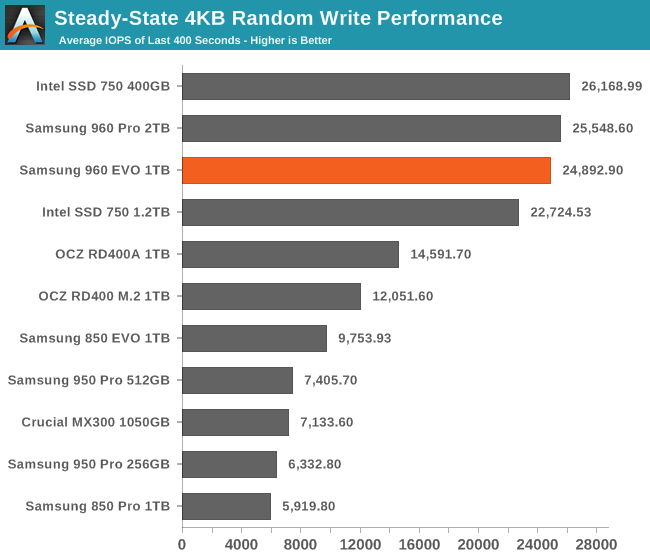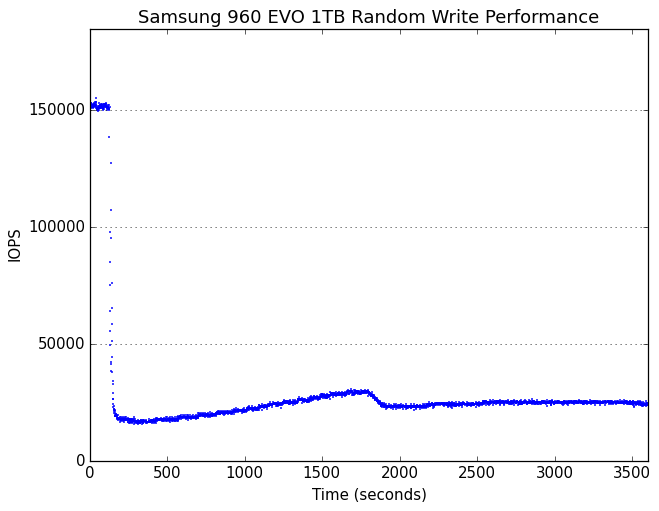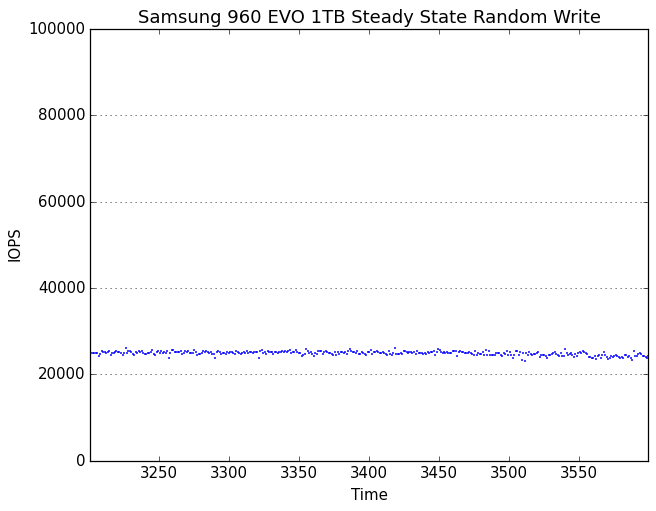The Samsung 960 EVO (1TB) Review
by Billy Tallis on November 15, 2016 10:00 AM ESTPerformance Consistency
Our performance consistency test explores the extent to which a drive can reliably sustain performance during a long-duration random write test. Specifications for consumer drives typically list peak performance numbers only attainable in ideal conditions. The performance in a worst-case scenario can be drastically different as over the course of a long test drives can run out of spare area, have to start performing garbage collection, and sometimes even reach power or thermal limits.
In addition to an overall decline in performance, a long test can show patterns in how performance varies on shorter timescales. Some drives will exhibit very little variance in performance from second to second, while others will show massive drops in performance during each garbage collection cycle but otherwise maintain good performance, and others show constantly wide variance. If a drive periodically slows to hard drive levels of performance, it may feel slow to use even if its overall average performance is very high.
To maximally stress the drive's controller and force it to perform garbage collection and wear leveling, this test conducts 4kB random writes with a queue depth of 32. The drive is filled before the start of the test, and the test duration is one hour. Any spare area will be exhausted early in the test and by the end of the hour even the largest drives with the most overprovisioning will have reached a steady state. We use the last 400 seconds of the test to score the drive both on steady-state average writes per second and on its performance divided by the standard deviation.

The 960 EVO's steady state random write speed is not quite as fast as the 960 Pro, but it's in the same league and much faster than most consumer SSDs.

The 960 EVO sets a new record for combining high performance with consistency. It's a bit slower than the 960 Pro, but less variable.
 |
|||||||||
| Default | |||||||||
| 25% Over-Provisioning | |||||||||
Highly consistent performance is a good thing, but it makes for a boring graph. The transitions from peak to sustained performance modes look the same for both the 960 Pro and the 960 EVO.
 |
|||||||||
| Default | |||||||||
| 25% Over-Provisioning | |||||||||
The 960 EVO responds to extra overprovisioning with even more consistent (and high) performance.










87 Comments
View All Comments
DanNeely - Tuesday, November 15, 2016 - link
The Intel 750 doesn't have power data in Bench. My guess would be that the current power benchmarks post-date when the review sample was returned.Sometimes there are oversights, but most of the time when some devices are only shown in a subset of the charts its because data to score them on the others isn't available. Most often due to moving testsuite targets or breaking changes in the benchmark applications.
http://www.anandtech.com/bench/SSD15/1440
http://www.anandtech.com/bench/product/1458
Billy Tallis - Tuesday, November 15, 2016 - link
Yeah, the Intel 750 was tested by Kristian before we had working PCIe power measurement. It also complicates things by using both the 12V and 3.3V rails, when I only have one meter. Adding power consumption data isn't a high priority for me, because the Intel 750 is always in last place, by a lot: its idle power is higher than the load power of most M.2 drives on many of the tests. The Intel 750 would distort the scale of the power graphs to the point that it would be hard to see the differences between the M.2 drives.willis936 - Tuesday, November 15, 2016 - link
How are M.2 drives mounted during these reviews? Do you use the motherboard's M.2 connector? A PCIe adapter without a heatsink? A PCIe adapter with a heatsink?Billy Tallis - Tuesday, November 15, 2016 - link
Unless otherwise specified, M.2 PCIe drives are tested in a simple Lycom DT-120 adapter, which is connected to the riser card used for power measurement, which is in turn connected to the primary PCIe 3.0 x16 slot. Drives like the OCZ RD400A and Plextor M8PeY are also tested in their bundled adapter cards with whatever heatsink that provides, and any other M.2+heatsink results I report are using the Angelbird Wings PX1 adapter and heatsink.R3MF - Tuesday, November 15, 2016 - link
Is that v2.0 driver available on day one?(for Windows7 users wanting to do a fresh install)
CrazyElf - Tuesday, November 15, 2016 - link
First, it is the drive that will likely play a role in making M.2 SSDs a much more popular form factor, perhaps to the point where NVMe drives overtake SATA. Most people do not need the write endurance that the MLC SSDs have.Second, the performance is quite good, and although there is still a huge price premium over SATA SSDs, the massive performance increase is much more justifiable in terms of cost premium compared to say, the 960 Pro, which is for people who want the best. It will remain that way, until the 970 Pro and Evo come out, or perhaps until a 3D XPoint SSD comes out.
Third, I expect an enterprise version to come out too, with power loss protection. The only real issue i see is if there is something like the 840 Evo that caused performance drops, but so far Samsung's TLC drives since then have been solid.
TheinsanegamerN - Tuesday, November 15, 2016 - link
I believe the 840 evo was planar NAND, whereas the newer designs are 3D NAND. That may be part of the reason.XabanakFanatik - Tuesday, November 15, 2016 - link
I see no mention of Samsung's silent delays of these drives. As of now most models of both the pro and evo are listed as ship by late December or January.Kind of disappointing you would gloss over a 2-3 month delay like that.
haukionkannel - Tuesday, November 15, 2016 - link
It seems that Samsung was lucky that their 250GB unit did fail...http://www.tomshardware.com/reviews/samsung-960-ev...
It seems to completely another series than 1Tb version.
TheinsanegamerN - Tuesday, November 15, 2016 - link
What are you trying to say here?